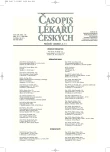-
Medical journals
- Career
Milestones of Cardiovascular Therapy. V. Diuretics
Authors: P. Jerie
Published in: Čas. Lék. čes. 2007; 146: 858-861
Category: Review Article
Overview
After their introduction in 1959, thiazide diuretics have become the cornerstone in the managment of heart failure and hypertension. They prevent sodium reabsorption in the upper segment of the distal tubule, increase the diuresis and, by diminishing the intravascular volume, they reduce the preload. With vigorous diuresis, cardiac output may drop under the critical level, and hypovolaemia, hypotension, syncopes and dehydratation with severe water-mineral disturbance may occur. A similar disorder takes place after aggressive administration of loop diuretics which act by the same mechanism at the ascending limb of the loop of Henle. Moreover, any chronic treatment with saluretics triggers the contraregulatory activation of RAAS. Thus, the dosing should be cautiously titrated, and with diminishing efficacy the diuretic is to be replaced by another one, or a second drug is to be added. With any potent diuretic agent, electrolyte depletion may occur; therefore, minimal active doses should be applied, potassium-sparing diuretics added or a pause should be inserted after/before furosemide with spirolactone. Hyponatraemia and hypokalaemia are common, and in combined treatment with ACE-inhibitors and spirolactone, hyperkalaemia is frequent. With long-term treatment, a rebound period of sodium reabsorption follows, and the diuretic effect is reduced or lost. To overcome this „diuretic resistance“, the dietary sodium is to be restricted, physical effort avoided and salt retaining drugs (NSAIDs and similar) eliminated. In the article, a short review of basic physiology concerning the water-electrolyte balance and the distribution of body-water is summarized.
Key words:
diuretics, acetazolamide, spironolactone, triamterene, intermittent diuretic treatment, body-water.
Labels
Addictology Allergology and clinical immunology Angiology Audiology Clinical biochemistry Dermatology & STDs Paediatric gastroenterology Paediatric surgery Paediatric cardiology Paediatric neurology Paediatric ENT Paediatric psychiatry Paediatric rheumatology Diabetology Pharmacy Vascular surgery Pain management Dental Hygienist
Article was published inJournal of Czech Physicians

-
All articles in this issue
- The Importance of Screening for Thyroid Dysfunction During Pregnancy: Pathophysiological Background and Practical Implications
- Reflection on the Physiological Mechanisms of Movements Controlled by the Spinal Cord – Brain Interaction
- Nutrigenetics and Nutrigenomics
- The Interpreter Role of Clinical Geneticist in the Process of Genetic Testing
- Silent Ischemia and Noisy Stunning: A Perspective of the Cause and Hints of Associations
- Thromboembolism in Pregnancy – Physiology and Pathophysiology of Hemocoagulation Changes During Normal and Pathological Gravidity
- Milestones of Cardiovascular Therapy. V. Diuretics
- Significance of Serum Antibodies ANCA, ASCA, ABBA in Diagnostics of Idiopathic Intestinal Inflammations
- Pilot Study to Evaluate Blood Glucose Control by a Model Predictive Control Algorithm with Variable Sampling Rate vs. Routine Glucose Management Protocol in Peri- and Postoperative Period in Cardiac Surgery Patients
- Changes of Plasminogen Activator Inhibitor (PAI-1) During Estrogen Replacement Therapy
- Tachycardia-Induced Cardiomyopathy
- Repeated Thrombosis of the Mechanical Heart Valve Prosthesis
- Journal of Czech Physicians
- Journal archive
- Current issue
- Online only
- About the journal
Most read in this issue- Significance of Serum Antibodies ANCA, ASCA, ABBA in Diagnostics of Idiopathic Intestinal Inflammations
- Nutrigenetics and Nutrigenomics
- Thromboembolism in Pregnancy – Physiology and Pathophysiology of Hemocoagulation Changes During Normal and Pathological Gravidity
- Changes of Plasminogen Activator Inhibitor (PAI-1) During Estrogen Replacement Therapy
Login#ADS_BOTTOM_SCRIPTS#Forgotten passwordEnter the email address that you registered with. We will send you instructions on how to set a new password.
- Career

